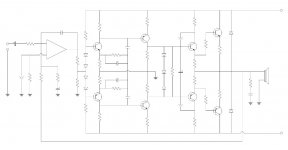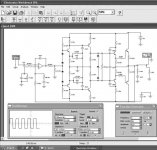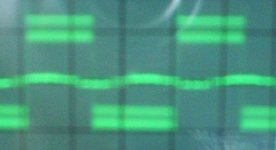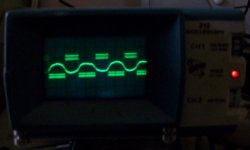Conclusion: Due to our efforts (real and bla-bla-bla also), the class D term already solidly associate with cool amp (and cold too). Congratulations!😎
With that little devil face he used beside his greet I have to wonder if this is a joke. Where's the mosfets, anyway?
This is one class d that's not going to run very cool.
This is one class d that's not going to run very cool.
Hi,
Believe it or not, it runs in classD, it is quite a different approach than other classD amps, but I like to be different! 🙂
I have never had a problem with heat on this amp, I even tested it with a 8x8cm piece of aluminium for a heatsink, without blowing up anything... I ran it into a 2ohm load for about an hour before i could actually feel it starting to heat up. 😉
This amp isn't picky about what tipe of output transistors you use, it can be built with lots of other tipes of transistors. I'll post some pics of it running on a scope.
You could even simulate it on a computer to check if it is classD, it really is and it makes a nice subwoofer amplifier! I'll explain the circuit later.
Cheers
Believe it or not, it runs in classD, it is quite a different approach than other classD amps, but I like to be different! 🙂
I have never had a problem with heat on this amp, I even tested it with a 8x8cm piece of aluminium for a heatsink, without blowing up anything... I ran it into a 2ohm load for about an hour before i could actually feel it starting to heat up. 😉
This amp isn't picky about what tipe of output transistors you use, it can be built with lots of other tipes of transistors. I'll post some pics of it running on a scope.
You could even simulate it on a computer to check if it is classD, it really is and it makes a nice subwoofer amplifier! I'll explain the circuit later.
Cheers
Attachments
after seeing values I now understand that it isn't working linear amplifier.
But still cannot see how it is class D, waiting for further explaination. Guess I'm not alone...
But still cannot see how it is class D, waiting for further explaination. Guess I'm not alone...
Hi,
According to your workbench schematic it looks to me like you're inputing a 1Khz sine wave and getting a square wave as output.
Looks like a simple amp with way too much gain.
It may modulate and may make sound, however, You require a proper filter on the output to reconstruct the sine wave. For those who would mention it, I do know about filterless class d, and this isn't it, not a fan of the idea either.
Perhaps an easy mod for this would be a complimentary MOSFET output stage/LC filter.
Regards,
Chris
According to your workbench schematic it looks to me like you're inputing a 1Khz sine wave and getting a square wave as output.
Looks like a simple amp with way too much gain.
It may modulate and may make sound, however, You require a proper filter on the output to reconstruct the sine wave. For those who would mention it, I do know about filterless class d, and this isn't it, not a fan of the idea either.
Perhaps an easy mod for this would be a complimentary MOSFET output stage/LC filter.
Regards,
Chris
I've just tested some similliar thing yesterday, 10 watt maximium output, 1% THD at mid power levels.
Hi,
Thanx for the reply's, I'll play around a bit more on the weekend, and post some new stuff.
I'm not using this amp for a HI-FI system, I only use 2 of these in bridge mode into a 4ohm subwoofer, which to me is more than enough for now.
I took a photo of it on my scope again today, looks alot better. I'll take some more as soon as I hook it onto a better power supply... Currently it is running on a cheap and very badly filtered SMPS for further testing.
Kenshin, did you actually build this amp, or did you simulate it? I'm getting around 150W whithout bridging the amp into 4ohms.
If anyone wants to build this amp, I'd also recommend changing the BC546 to 2SC945 and the BC556 to 2SA1266, as these transistors give lower distortion.
As far as reconstructing the sine wave is concerned, almost all of the research that I done tells me that a classD amplifier isn't supposed to reproduce the sine wave, meaning that the output should look like a square wave. I'll post some of my sources shortly if anyone is interested?
According to the FAQ that can be found at www.digitalamp.com:
“What is a Class-D amplifier?
The strict definition of a Class-D amplifier only requires that the output devices are used as switches. Fictitious class names that refer to switching amplifiers are actually referring to Class-D. Switching amplifiers are therefore Class-D amplifiers.”
Attached a another pic.
Cheers for now... 🙂
Thanx for the reply's, I'll play around a bit more on the weekend, and post some new stuff.
I'm not using this amp for a HI-FI system, I only use 2 of these in bridge mode into a 4ohm subwoofer, which to me is more than enough for now.
I took a photo of it on my scope again today, looks alot better. I'll take some more as soon as I hook it onto a better power supply... Currently it is running on a cheap and very badly filtered SMPS for further testing.
Kenshin, did you actually build this amp, or did you simulate it? I'm getting around 150W whithout bridging the amp into 4ohms.
If anyone wants to build this amp, I'd also recommend changing the BC546 to 2SC945 and the BC556 to 2SA1266, as these transistors give lower distortion.
As far as reconstructing the sine wave is concerned, almost all of the research that I done tells me that a classD amplifier isn't supposed to reproduce the sine wave, meaning that the output should look like a square wave. I'll post some of my sources shortly if anyone is interested?
According to the FAQ that can be found at www.digitalamp.com:
“What is a Class-D amplifier?
The strict definition of a Class-D amplifier only requires that the output devices are used as switches. Fictitious class names that refer to switching amplifiers are actually referring to Class-D. Switching amplifiers are therefore Class-D amplifiers.”
Attached a another pic.
Cheers for now... 🙂
Attachments
Try this amp, you might be surprised?
It's really cheap and quite easy to build.
Cheerz
Sousmielie
It's really cheap and quite easy to build.
Cheerz
Sousmielie
Hmmm,
I don't pretend to be at all experienced in ClassD however i must confess that your design looks more like a giant schmitt trigger to me rarther than a peice of audio equipment. I must admit however if its only low frequencys you are after then this might be a rarther neat and cheap soloution to getting wads of that juicy low frequency stuff as the inductance of your speaker coil should go a fair way towards turning the square wave into a sine. You must get shockingly loud and audible harmonics when using this design though!...... Unless you know somthing i don't ( this is quite possible as i've only just started to dabble in this area myself ).
P.S Class D amps are not digital and do produce nice smooth sinewaves. Good luck with the experimenting, not many use the hands on approach anymore🙂
Mad.P
I don't pretend to be at all experienced in ClassD however i must confess that your design looks more like a giant schmitt trigger to me rarther than a peice of audio equipment. I must admit however if its only low frequencys you are after then this might be a rarther neat and cheap soloution to getting wads of that juicy low frequency stuff as the inductance of your speaker coil should go a fair way towards turning the square wave into a sine. You must get shockingly loud and audible harmonics when using this design though!...... Unless you know somthing i don't ( this is quite possible as i've only just started to dabble in this area myself ).
P.S Class D amps are not digital and do produce nice smooth sinewaves. Good luck with the experimenting, not many use the hands on approach anymore🙂
Mad.P
sousmielie said:Try this amp, you might be surprised?
It's really cheap and quite easy to build.
Cheerz
Sousmielie
If you added some feedback and tamed the gain you'd probably have some kind of A/B amp. This sucker is not at all class d.
In order to build a class d amp, you first have to have a solide understanding of what one is, and how it works, then, you have to start learning about how to switch mosfets, you're in for alot of fun there!
The key to a good amp is linearity. Theoretically class d is just like class A, 100% linear. In practice, neither is. The game is in seeing how close you can get to it.
Linear means that the output is identical to the input. If you input a straight line (like a DC voltage), a straight line is what you should see on the output, + the gain factor, that means it shouldnt' look like a sine wave or a square wave or anything other than a straight line that's boosted in gain.
Perhaps one source of confusion here could be the so called "filterless" class d. Those are a joke by IC companies who want to sell products. They're telling manufacturers that it's OK to save 2$ on an output filter and that's what they love to hear.
They make very low powered IC modules, and must be connected directly to the speaker, even still, the output of them looks nothing like yours.
Nitrate was 100% correct, there's no way this can modulate it's basically working like a comparator or maybe a schmitt trigger.
Any sound you get out of this just can't be good at all. I regret to inform you that you're totally suffering from the "my baby ain't ugly" syndrom. I think you're ruining your hearing if you're actually listening to this.
I don't want to discourage you at all, I still like the effort you made, I just want to give you a shove in the right direction.
So, start by reading this:
http://en.wikipedia.org/wiki/PWM_amplifier
and continue by also following the link they reference at the bottom of the page.
1.
From there, you should have some questions, hit google and start answering them.
go to 1.
Looks like an endless loop huh, it is.
Here is one you should be looking at as well:
http://www.irf.com/technical-info/appnotes/an-1071.pdf
Take a very close look at figure 2, stare at it until a revelation clicks. That's how a class d amp works.
I look forward to seeing your next amp.
Regards,
Chris
I haven't build yours. Mine is a low power transistor one ("like yours" just means use transistor instead of MOSFET as switches), 10 watt, with LPF & with half the feedback after LPF.
schematic (old version) at
http://spaces.msn.com/members/classd
schematic (old version) at
http://spaces.msn.com/members/classd
nitrate said:your design looks more like a giant schmitt trigger to me rarther than a peice of audio equipment.
Self-osc class D is just a giant schmitt trigger with feedback plus some passives. Sousmielie's amp has feedback, probaply it will oscillate and modulate.
LPF is NOT essential (most motor controllers switching below 20KHz don't) , though running without LPF would cause a large EMI emission and may cook the sound coil.
But the switching stage is too complicated and include some unused things (diode bias).
Kenshin said:
Self-osc class D is just a giant schmitt trigger with feedback plus some passives. Sousmielie's amp has feedback, probaply it will oscillate and modulate.
LPF is NOT essential (most motor controllers switching below 20KHz don't) , though running without LPF would cause a large EMI emission and may cook the sound coil.
But the switching stage is too complicated and include some unused things (diode bias).
Nah, if you look at his schematic and also the output waves, you can see it's basically a 3 stage amp with very high gain, and that the output switches at input zero crossing, it's not modulating anything.
- Status
- Not open for further replies.
- Home
- Amplifiers
- Class D
- Sousmielie Class D amp




